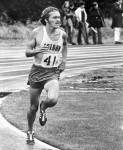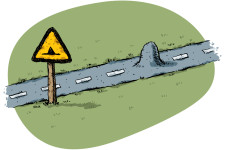Eccentric Heel Dips – The Magic Elixir!
We runners have some predictable issues and injuries. Starting from the bottom the most prevalent are plantar fasciitis (PF), Achilles tendinitis, calf strains, sore knees, tight hamstrings, hip and groin strains, and lower back pain. If you’ve been running very long, you’ve probably had bouts with all of these. I certainly have! What to do? Could there be a one-size-fits-all solution to these multiple maladies up and down the kinetic chain? Well, no. But I have found one rather simple exercise that both directly and indirectly addresses these issues – eccentric heel dips. I think some of my clients consider me eccentric and obsessive when I impress upon them the importance of doing them – day in and day out. Perhaps they are right. Meanwhile I take my own medicine and perform them multiple times each day. Here’s the basic description: Stand on the edge of a stair or any kind of a riser that allows you to dip your heels to a comfortable stretch. Supported only by the front of your foot, allow your body weight to stretch the heel downward, allowing one foot to take the majority of the weight. When you hit bottom, and just after a … Continue reading



